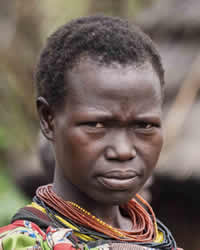Ik in Uganda

Photo Source:
Rod Waddington - Flickr
Creative Commons
|
Send Joshua Project a map of this people group.
|
| People Name: | Ik |
| Country: | Uganda |
| 10/40 Window: | No |
| Population: | 16,000 |
| World Population: | 17,600 |
| Primary Language: | Ik |
| Primary Religion: | Christianity |
| Christian Adherents: | 85.00 % |
| Evangelicals: | 2.20 % |
| Scripture: | Portions |
| Ministry Resources: | No |
| Jesus Film: | No |
| Audio Recordings: | Yes |
| People Cluster: | Khoisan |
| Affinity Bloc: | Sub-Saharan Peoples |
| Progress Level: |
|
Introduction / History
The Ik live in the Tinu sub-county, Kabong district, in the northeastern corner of Uganda. This people group has maintained its separate cultural identity and unique language.
The Ik are divided into twelve exogamous patriclans. The order reflects the relative size of the clans. The men are separated in age groups.
What Are Their Lives Like?
The primary economic activity of the Ik is farming. They mainly grow millet and maize. But in spite of the dominant role played by agriculture in the traditional economy, hunting and gathering are also important economic activities. They also trap white ants and collect honey.
What Are Their Beliefs?
The most important social and religious event in the annual cycle is "it w - s" (the "blessing the seeds" ceremony), which lasts three days in late December/early January and marks the beginning of the agricultural year. The second most important Ik ceremony is called "dz ber-ika mes" (the beer of the axes). Like "it w - s", "dz ber-ika mes" is also related to farming (November or December), to bless the agricultural tools with beer. Of almost equal importance is "m n m- s" (opening the harvest), which is celebrated around August.
In the 1950s, Catholic missionaries were reaching out to the Ik and baptizing. Most Ik belong to the Catholic Church but the priest visits the Ik only once a year.
What Are Their Needs?
The Ik do not have the Bible in their language and do not have much knowledge of the Bible.
Prayer Points
Pray for the Holy Spirit to move in Ik churches and families.
Pray that soon Ik disciples will be making more disciples.
Pray for them to understand that God is their provider.
Pray for thankfulness and dedication to the Lord.